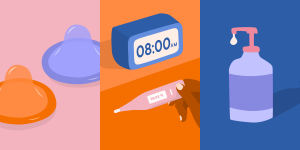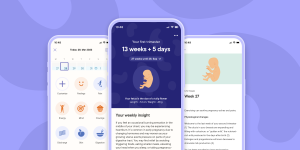Illustration by Marta Pucci and Emma Günther
Ovulation bleeding 101
What ovulation bleeding is, and how to know if you’re experiencing it

Top things to know about ovulation bleeding:
Ovulation bleeding (spotting) is uncommon
Ovulation bleeding is usually a few drops of light red or pink blood
Ovulation pain is a sharp, cramp-like pain felt on either side of the lower abdomen
Consider contacting your healthcare provider for frequent or heavy mid-cycle bleeding
Bleeding between your periods may surprise you. It may feel inconvenient or cause you to worry. Most of the time, bleeding or spotting between periods is no reason for concern. For some, ovulation may be the cause of the spotting.
*If you are in the menopause life stage, and have not experienced period bleeding for over one year, new spotting or bleeding indicates a need for follow-up with a healthcare provider.
How do I know when ovulation is happening?
Ovulation is when an ovary releases an egg (1,2). The egg travels down the fallopian tube towards the uterus. It will either connect with sperm within 24 hours, or it will break down and be shed two weeks later with the period (2).
Some people feel ovulation pain or “mittelschmerz”—a sharp or cramp-like pain felt on either side of the lower abdomen that can last a few hours or days (3). It may come with a bit of blood or spotting (4).

As the menstrual cycle gets closer to ovulation, hormones typically cause cervical fluid volume to increase. You can see this fluid in your underwear or on toilet paper when you use the bathroom. It becomes more stretchy, clear, wet, and slippery—similar to a raw egg white. You might notice more of this fluid 1-2 days before ovulation when estrogen is highest (5).
Before ovulation, a surge in luteinizing hormone (LH) happens, which triggers an egg to be released from a follicle (a small sac in the ovary) (6). This LH surge happens 36-40 hours after a spike in estrogen (7). Ovulation test strips or kits can identify LH in urine (6).
Basal body temperature (BBT) is a sign that ovulation has already happened (1). BBT dips right before ovulation and rises slightly (0.5-1.0℉) after ovulation (1). Typically, 2-3 days before BBT rises is when people are most likely to conceive (1). The hormone progesterone starts to increase after ovulation; this prepares the uterus to attach to a fertilized egg (8). The rise in progesterone after ovulation causes a slight increase in BBT (8). BBT tests can also be used with ovulation prediction tests/kits (OPKs), but aren’t recommended by fertility professionals.
What causes ovulation bleeding or “spotting”?
Spotting is defined by researchers and healthcare providers as light vaginal bleeding that does not require the use of any menstrual product protection (i.e. a pad or tampon) (9). Ovulation spotting happens during ovulation, when an egg is released from an ovary. The change in hormones during ovulation can allow some of the uterine lining to shed (2). This will be very light and often goes unnoticed because it is so little. Ovulation bleeding probably occurs in 5% or fewer people (4).
Spotting can be caused by other factors too, like hormonal birth control use (the pill, IUDs, etc.), pregnancy, fibroids, polyps, infections, physical uterine changes, and bleeding conditions (10).
Mid-cycle bleeding that is not related to a reproductive condition, such as fibroids, may be caused by lower estrogen levels during the middle of the cycle (11).
What does ovulation spotting look like?
Ovulation spotting is very light and doesn’t last long. It may only be a few drops and is usually pink or light red in color. Cervical fluid is thin and slippery near ovulation. If ovulation spotting happens, it may be mixed with cervical fluid.
What readers have to say:
Since we’re curious, we asked the Clue community if anyone had experienced ovulation bleeding.
“The months I have ovulation bleeding, I notice that my periods are lighter but my PMS cramps are stronger. During months when I don’t have it, my cycle is longer, my periods are heavier, and my breasts are more tender. I also tend to have more ovulation bleeding when I’m taking supplements that change my hormone levels.” - Karly
“A few months ago I experienced a small bleed during ovulation. It was so light I don’t know if I would even call it a bleed, more like spotting. Initially, I freaked out. I track my periods and my symptoms rigorously so I wasn’t sure why it was happening. When I clicked into the Clue app to log this, I checked out the information page on bleeding, and it says that spotting around ovulation is a normal phenomenon. I knew I was ovulating that day, so Clue helped me put two and two together. Ovulation bleeding has definitely made me more aware of my fertile window, as it usually only happens on the day Clue predicts I will ovulate." - Amy
Only some people notice ovulation spotting because it is usually very light. It is just one cause of mid-cycle bleeding and is not anything to be worried about. There are other causes for bleeding between periods that may require help from a healthcare provider. If you regularly bleed between periods or experience unusually heavy bleeding between your periods, talk to your healthcare provider.
Download Clue to track your menstrual experiences and get to know your body better.
Article was originally published on Oct. 11, 2017.




